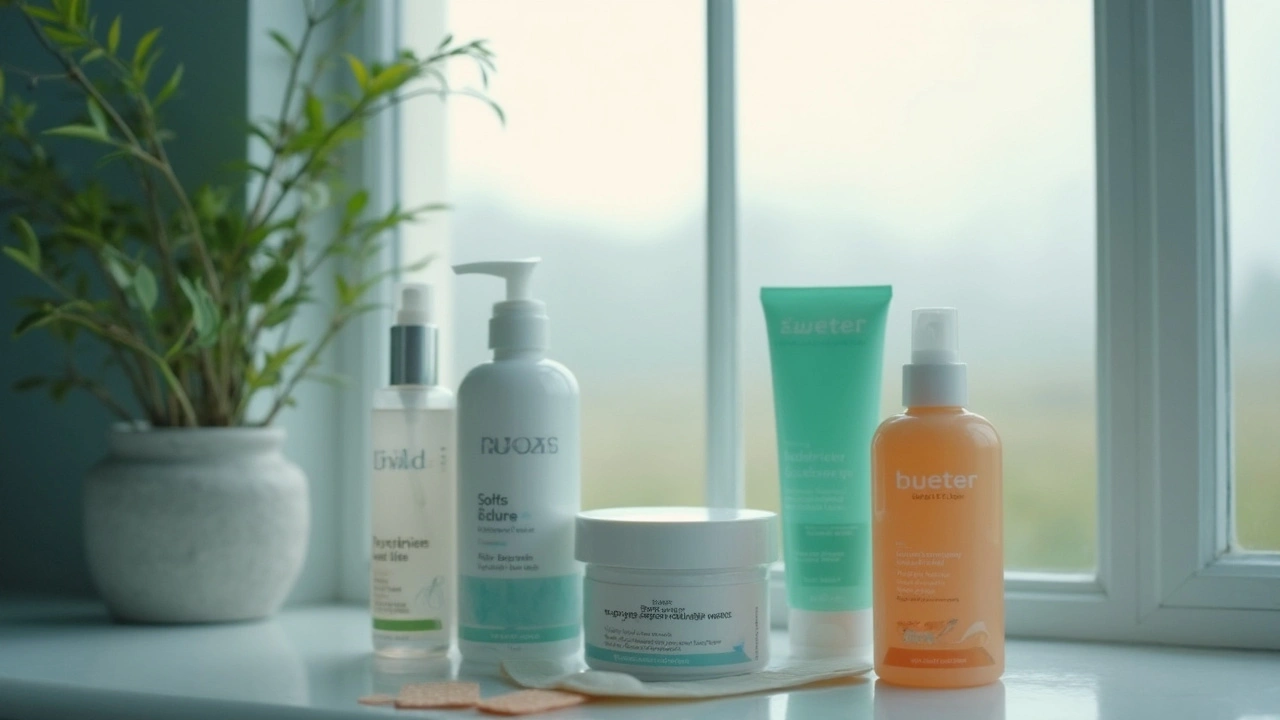
Getting a scar from a sports injury isn’t just about the pain—it leaves a mark that can be there for a long time. Ever wondered how some athletes have flawless skin despite all the bumps and bruises? It’s mostly about how they care for their injuries from the get-go.
First off, when you get injured in sports—even if it seems minor—clean the wound right away. Grab some soap and water, and gently wash out dirt to prevent infection. If you’ve got an open cut, apply some antibiotic ointment and cover it up with a clean bandage. This might sound basic, but infection is scar’s best friend.
Now, here’s something interesting: staying hydrated actually helps your skin heal better. Water keeps your skin elastic and resilient, so chug that H2O! Also, if you’re out in the sun a lot, slap on some sunscreen. UV rays can make scars darker and more noticeable.
For long-term care, once the wound has closed up, think about using silicone gel or sheeting. Studies—yes, real studies—show they help flatten and fade scars. A little patience here goes a long way. It’s not going to disappear overnight, but over time, you’ll see improvement.
- Understanding Sports Injuries and Scars
- Immediate Treatment for Injury
- Skincare Tips to Prevent Scarring
- Additional Scar Treatment Options
Understanding Sports Injuries and Scars
Alright, let's talk about the nature of sports injuries and how they can lead to scarring. When you're out there playing, whether it's soccer, basketball, or even just a casual run, you’re putting your body through some intense action. And while that's great for fitness, it can also mean more cuts, bruises, and sometimes deeper injuries.
The Mechanics of Scars
A scar forms as your body's way of healing an injury. Think of it like nature’s band-aid. When you get a cut or a scrape, your body rushes to heal the skin. It sends collagen—a type of protein—to the rescue. This patch-up work naturally ends up looking a bit different from your normal skin, hence, a scar.
Common Sports Injuries Leading to Scars
Let’s look at some common sports injuries that often result in scars:
- Cuts and Lacerations: These occur frequently, especially in contact sports. The deeper the cut, the more likely it is to scar.
- Abrasions: These are the result of skin scraping against a rough surface. They're pretty common when you take a tumble on the field or court.
- Surgical Scars: Sometimes, injuries require surgery, leaving behind surgical scars that need special attention.
It’s important to understand that while you can prevent a cut from becoming a big mark, not all scars can be avoided. However, knowing the types of injuries can help in better management.
The Skin's Role in Healing
Your skin is your body's largest organ and has an amazing ability to heal itself, but it needs a bit of help to do its best work. Staying hydrated, eating well, and avoiding excess sun exposure are key factors. They keep your skin healthy and improve healing processes.
Here’s a statistic: According to studies, over 30% of athletes face visible scars from sports injuries during their careers. Managing how we handle these injuries can make a difference.
Immediate Treatment for Injury
When you get a sports injury, the first few minutes can make a big difference in how the scar turns out. Let's break down what you should do right away.
Step 1: Clean the Wound
Right after an injury, it's crucial to clean the area. Use water and mild soap to rinse away dirt and debris. This simple step prevents bacteria from settling in, which could lead to infection and worsen the scar.
Step 2: Stop the Bleeding
If it's bleeding, apply gentle pressure with a clean cloth or bandage. Elevating the injured area can also help slow down bleeding.
Step 3: Apply an Antibiotic
After cleaning, use an antibiotic ointment. This not only helps prevent infection but also keeps the skin moist, aiding in quicker healing. An infected cut is more likely to become a pronounced scar.
Step 4: Cover It Up
Once you've got it cleaned and treated, cover the wound with a sterile bandage. Change the dressing daily or whenever it gets wet or dirty. Keeping the wound covered helps in protecting it from further injury or bacteria.
Step 5: Manage Swelling
Use ice packs on and off (20 minutes at a time) to manage swelling. This helps control inflammation, which in turn can minimize scar formation. Also, trials show that managing swelling well can shorten the healing time by up to 30%!
Avoid picking at scabs, as tempting as it might be. Scabs protect the healing skin underneath, and picking them off can lead to worse scarring.

Skincare Tips to Prevent Scarring
Alright, so you’ve managed your injury, but how do you make sure it doesn’t leave a mark? It’s time to talk skincare, folks. Preventing scars from sports injuries requires a solid skincare routine. Here are some tips to keep that skin looking fresh and clean.
Clean and Moisturize
The golden rule of skincare is to keep it clean, but don’t overdo it. Gentle cleansing avoids stripping your skin of its natural oils. Right after washing, hydrating with a good moisturizer locks in moisture and keeps the skin supple. Look for products with hyaluronic acid or ceramides—skin’s best pals for staying soft.
Use Sun Protection
Don’t underestimate the power of sunscreen. The sun can make scars more visible, so applying broad-spectrum SPF 30 or higher is crucial if you’ll be exposed to sunlight. Clouds don’t block UV rays, so wear it even on overcast days.
Consider Over-the-Counter Products
For preventing scar formation, check out silicone gel or sheets. They work wonder by hydrating and protecting the scar surface. Vitamin E creams are also popular, but research is mixed about their effectiveness. Always patch test to prevent allergic reactions.
Nutrition Matters, Too
A balanced diet helps your skin heal. Vitamin C and zinc are great for skin repair. Think citrus fruits or nuts. Pretty tasty and good for you—a win-win! Green smoothies, anyone?
Keep an Eye on It
If a scar starts looking weird, like extra red or swollen, see a dermatologist. Early intervention can save you from long-term issues. No one wants a nasty surprise months later.
Fun Fact
| Common Sports Activities | Injury Risk Factor |
|---|---|
| Basketball | High |
| Swimming | Low |
| Running | Moderate |
Remember, every injury and scar is unique. What works for your buddy might not work for you, so listen to your skin. Keep experimenting with what suits you best, and you’ll be on your way to healing without a trace.
Additional Scar Treatment Options
Alright, so maybe you've been diligent about cleaning and covering up, but that scar is still sticking around. Don't worry, there are more ways to tackle it!
Over-the-Counter Treatments
Your first stop might be heading to the pharmacy for some scar treatment creams. Products containing onion extract, like Mederma, or vitamin E are popular options. They aim to reduce scar appearance and soften the skin. Just remember to read the instructions and be consistent.
Natural Remedies
Some folks swear by natural remedies. Aloe vera is a classic—it's soothing and known for promoting healing. Then there's honey; raw honey is loaded with properties that help skin repair itself. Just massage it lightly onto the scar and let it do its thing.
Laser Treatments
For those pesky scars from sports injuries that just won’t fade, consider laser treatments. These are done by professionals and target different types of scars. Whether it’s moving scar tissue or encouraging new collagen production, lasers can be a game-changer.
| Treatment | Average Cost |
|---|---|
| Over-the-Counter Creams | $10 - $30 per tube |
| Laser Treatment | $200 - $600 per session |
Dermal Fillers
If your scar is indented, dermal fillers might help. They fill the depression in the skin, making the surface appear smoother. Usually, these injections are a temporary solution, but they can make a big difference when done correctly.
Surgical Options
When nothing else works, surgery could be an option. Plastic surgeons can remove the old scar and close the area with very fine stitches, which aims to leave a more cosmetically pleasing line. This is usually a last resort, but for some, it’s worth it.
Before you decide on any of these treatments, it's a smart move to chat with a professional who can guide you based on your specific scar type and skin condition. Whatever path you choose, remember to keep your expectations realistic and give your skin some time to recover.


Keeping the wound clean and covered is the basics, but staying hydrated really speeds up the healing.
When you stub a knee or get a nasty cut on the field, the first thing you do can make the difference between a faint line and a scar that follows you for years.
I’ve seen teammates ignore a small abrasion, only to watch it swell, infect, and turn into a raised, discolored ribbon of skin.
The secret sauce, if you will, starts with a thorough rinse using lukewarm water and a mild soap to strip away debris without stripping the skin’s natural oils.
After the rinse, slap on a thin layer of antibiotic ointment-think bacitracin or neosporin-because a moist environment is a healing environment.
Then, protect the area with a breathable, non‑stick bandage that you change at least once a day, or sooner if it gets wet.
While you’re at it, drink a full glass of water every couple of hours; the hydration keeps collagen fibers flexible and reduces the chance of a tight, raised scar.
Don’t forget that electrolytes matter too-sports drinks with a pinch of sodium help maintain the fluid balance that your skin cells need to proliferate efficiently.
If you’re outside, slather on a broad‑spectrum SPF 30 or higher, because UV radiation can trigger hyperpigmentation and make even a tiny scar look like a tattoo.
Once the wound has closed, transition to silicone gel sheets or silicone‑based creams, which create a semi‑occlusive barrier that flattens the scar over weeks.
Clinical studies show that consistent silicone use for two to three months can cut the visible height of a scar by up to 40 %.
In addition, gentle massage with a vitamin C‑rich cream can stimulate collagen remodeling and improve elasticity.
Nutrition plays a backstage role-vitamin C, zinc, and protein are the building blocks of new tissue, so a post‑injury smoothie with orange juice, Greek yogurt, and a handful of almonds does wonders.
Avoid picking at scabs, even if they itch; each time you disturb the forming tissue you risk a contour that the body will fill in haphazardly.
If you notice excessive redness or a raised ridge after a few weeks, schedule a visit with a dermatologist; early laser or steroid treatment can nip a problematic scar in the bud.
Bottom line: a disciplined routine of cleaning, protecting, hydrating, and treating the wound is the fastest ticket to a clean‑skin comeback, and you’ll thank yourself when the scoreboard is the only thing that shows a scar.
From a cultural perspective, every sport has its own folklore of battle scars that become badges of honor, yet the science behind wound care transcends those myths.
In rugby‑loving nations, for instance, players often treat cuts with a quick swipe of a “crocodile” ointment, but that habit can trap moisture and invite infection if not followed by proper cleaning.
Conversely, Japanese martial artists historically use rice bran powders to keep wounds dry, a technique that aligns with modern principles of maintaining a balanced moisture environment.
Regardless of tradition, the universal rule remains: cleanse the wound with gentle, lukewarm water and a mild cleanser to remove debris without compromising the skin barrier.
After cleansing, a thin layer of antibiotic ointment acts like a shield, promoting a moist yet protected healing field.
Covering the area with a breathable dressing prevents external contaminants while allowing gas exchange, which is essential for collagen synthesis.
Hydration is not just a buzzword; systemic water intake supports dermal fibroblasts, the cells that lay down new collagen fibers.
Electrolyte replenishment through sports drinks can further aid cellular function, especially after intense exertion that depletes sodium and potassium.
Sun exposure after a wound closure can trigger melanocyte activity, leading to hyperpigmentation, so applying broad‑spectrum SPF is a non‑negotiable step.
When the epithelial layer is fully re‑established, silicone gel sheets become the gold standard for flattening and remodeling the scar tissue.
Clinical data highlight that a consistent 12‑hour daily silicone regimen over eight weeks can reduce scar elevation by up to 45 %.
Moreover, regular gentle massage with vitamin‑C enriched creams can stimulate collagen realignment, improving tensile strength and visual appearance.
A balanced diet rich in vitamin C, zinc, and protein supplies the necessary substrates for collagen cross‑linking and extracellular matrix formation.
Avoid the temptation to pick scabs; each disturbance reopens the wound and resets the inflammatory cascade, prolonging the maturation phase.
Finally, early consultation with a dermatologist for recalcitrant scars opens the door to laser therapy, steroid injections, or even microneedling, all of which can accelerate remodeling and reduce visibility.
While the preceding exposition offers a thorough regimen, it omits consideration of underlying comorbidities such as diabetes, which can markedly impair wound healing and alter scar formation trajectories.
Yo, all that talk bout "drink water" n "silicone sheets" is kinda overrated, u kno most scars just fade on their own if you chill.
Hey, I get where you’re coming from, but staying consistent with the basic steps-cleaning, covering, and a bit of hydration-really does cut down on the long‑term visibility of those marks.
Just keep it clean and covered.
Maintaining a simplistic "clean‑and‑cover" approach overlooks the nuanced interplay between collagen remodeling, UV‑induced melanogenesis, and the socioeconomic factors that dictate access to advanced treatments.